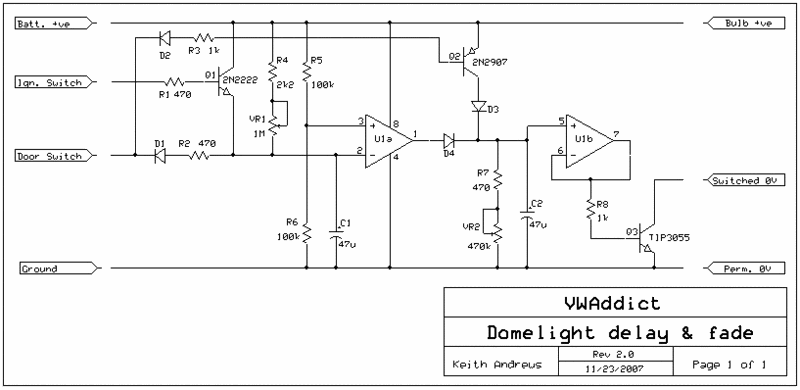SSLtech
Well-known member
I'm trying to come up with a comprehensive dome-light delay & fade circuit for adding into a couple of older cars.
I've seen a couple of circuits but nothing with everything that I'm looking for yet...
So I adapted the one that had MOST of what I was looking for:

There are two stages, U1a does the actual delay, which cancels when the ignition key is turned to the 'run' position. (I hate the wife's Volvo factory circuit, which keeps the light on even when you're trying to drive away!) D2/R3/TR2/D3 is the bit which I added on, trying to get the light to still come on if a door is opened with the engine running, but with NO delay when it's reclosed, unless of course the engine is switched off.
U1B is a buffer which drives the simple TR3 switch for a gentle 'fade-off'.
I can't say that I'm in love with the R8/TR3 fadeout circuit, because it depends on hfe, as well as the bulb's load resistance, and that makes a super-smooth fadeout hard to predict... but I don't want the circuit to be much more complicated.
Anything else anyone can suggest?
TIA,
Keith
I've seen a couple of circuits but nothing with everything that I'm looking for yet...
So I adapted the one that had MOST of what I was looking for:

There are two stages, U1a does the actual delay, which cancels when the ignition key is turned to the 'run' position. (I hate the wife's Volvo factory circuit, which keeps the light on even when you're trying to drive away!) D2/R3/TR2/D3 is the bit which I added on, trying to get the light to still come on if a door is opened with the engine running, but with NO delay when it's reclosed, unless of course the engine is switched off.
U1B is a buffer which drives the simple TR3 switch for a gentle 'fade-off'.
I can't say that I'm in love with the R8/TR3 fadeout circuit, because it depends on hfe, as well as the bulb's load resistance, and that makes a super-smooth fadeout hard to predict... but I don't want the circuit to be much more complicated.
Anything else anyone can suggest?
TIA,
Keith


